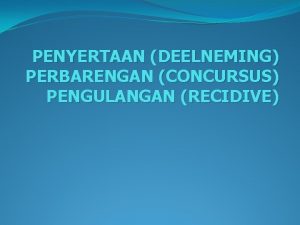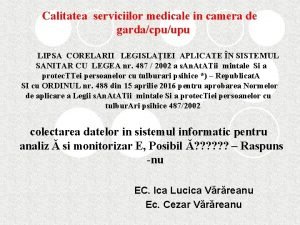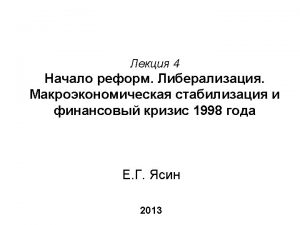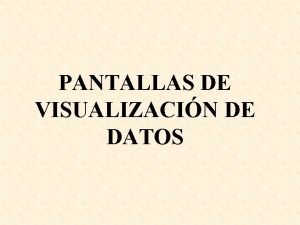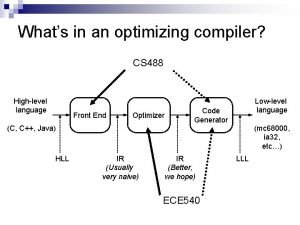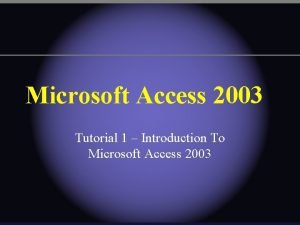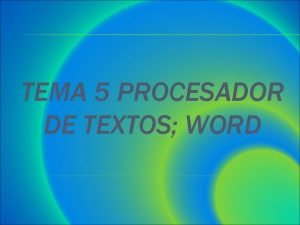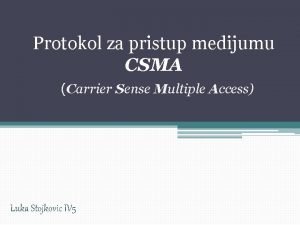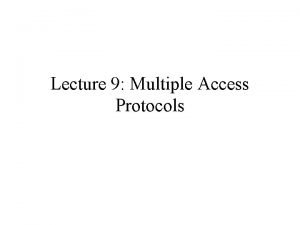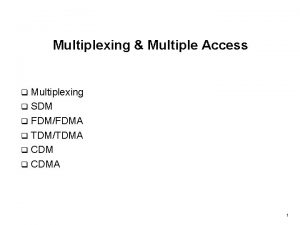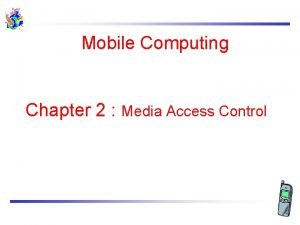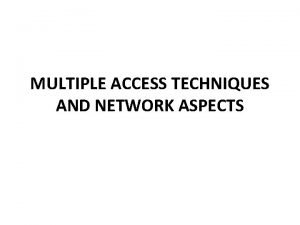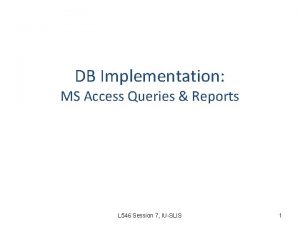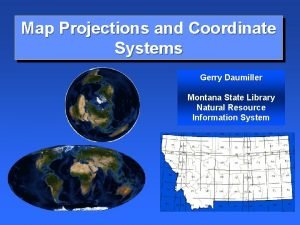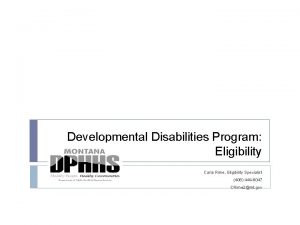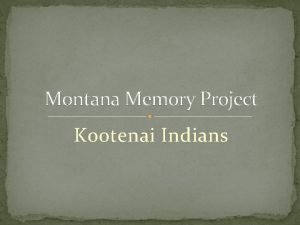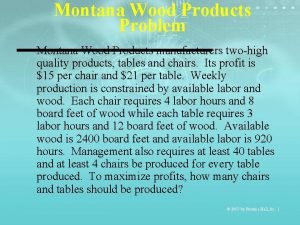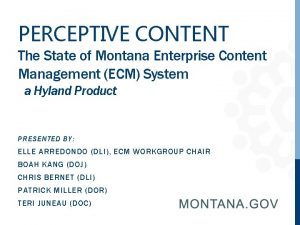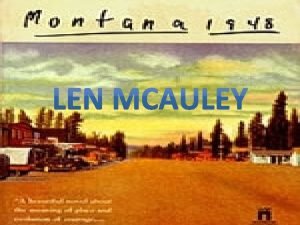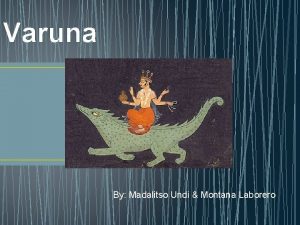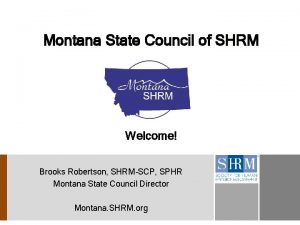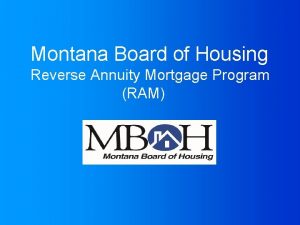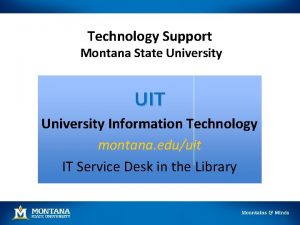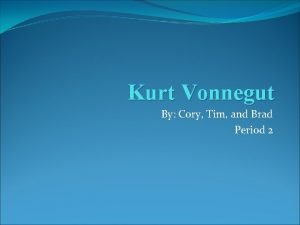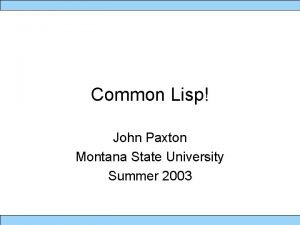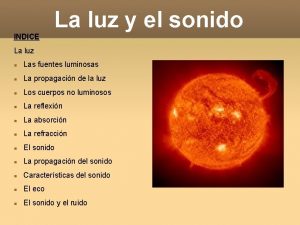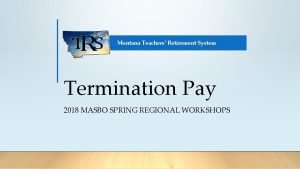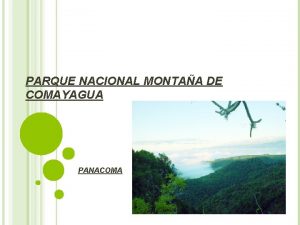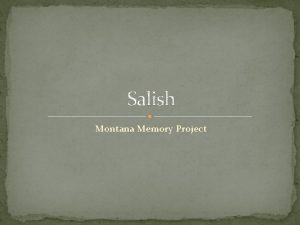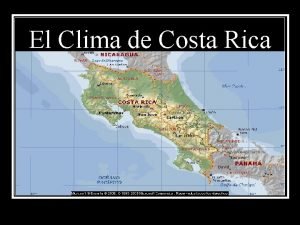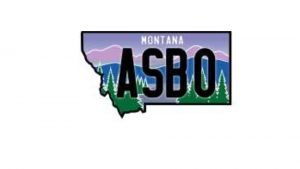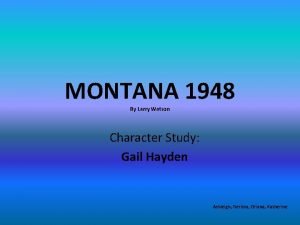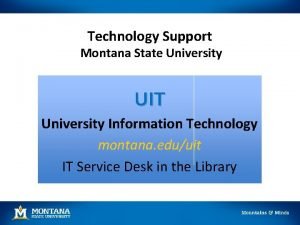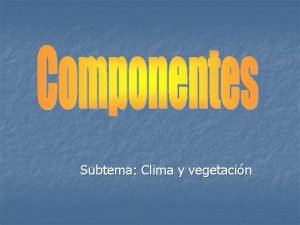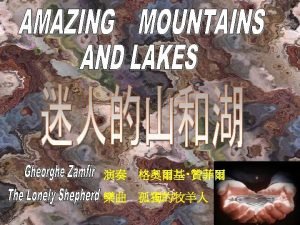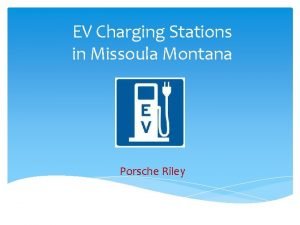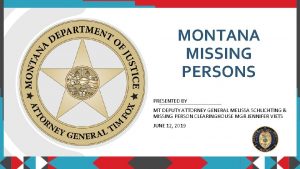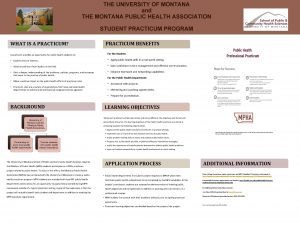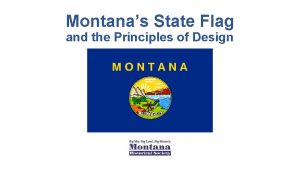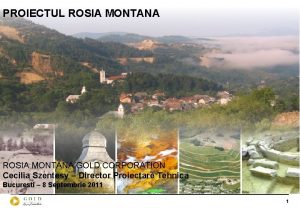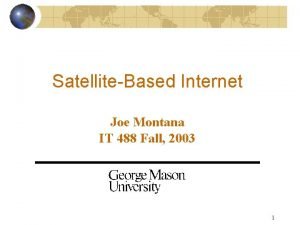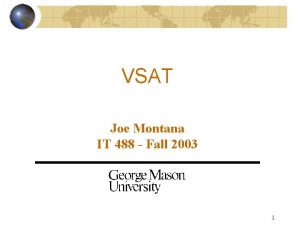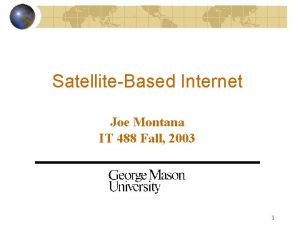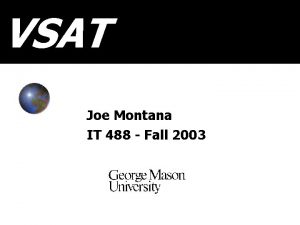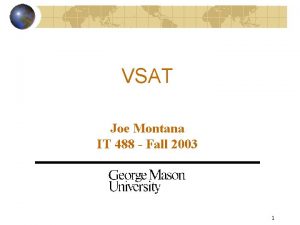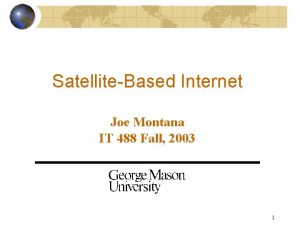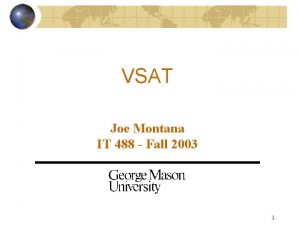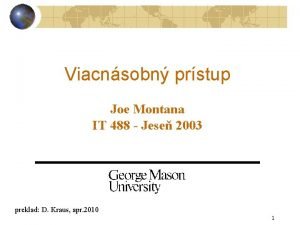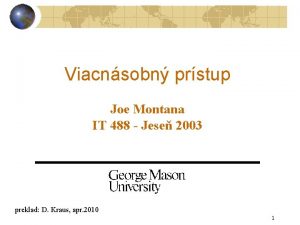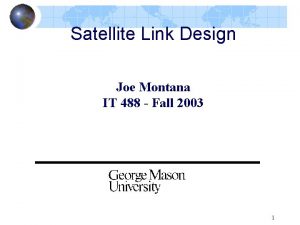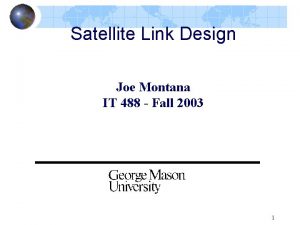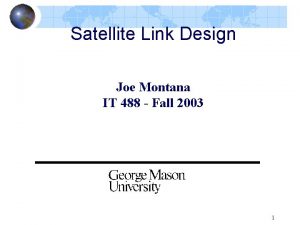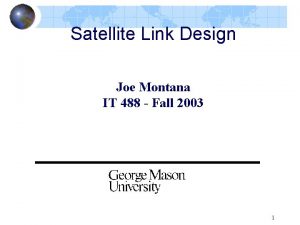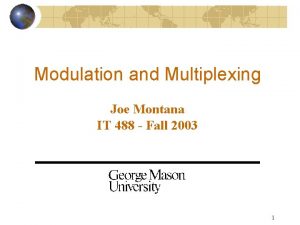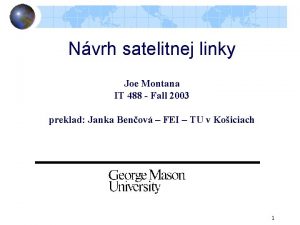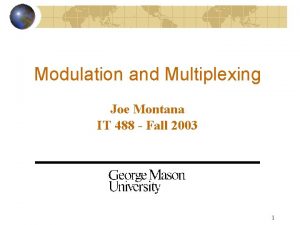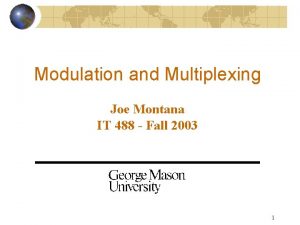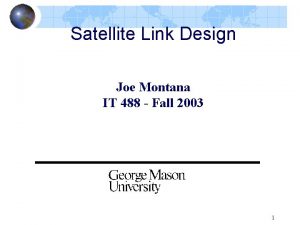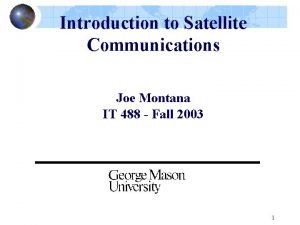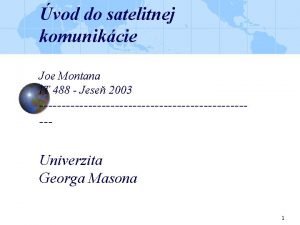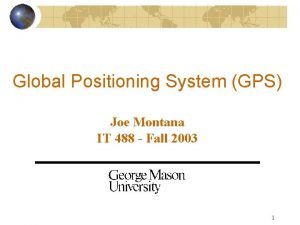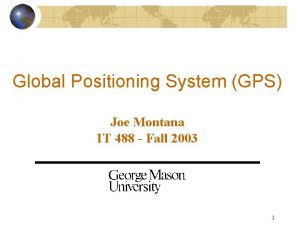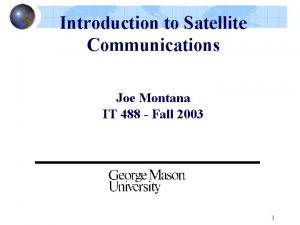Multiple Access Joe Montana IT 488 Fall 2003
























































- Slides: 56

Multiple Access Joe Montana IT 488 - Fall 2003 1

Agenda • Multiple Access Concept • FDMA • TDMA • CDMA • On Board Processing 2

Multiple Access Concept 3

MULTIPLE ACCESS - 1 THE PROBLEM: HOW DO WE SHARE ONE TRANSPONDER BETWEEN SEVERAL EARTH STATIONS? f 1 Satellite Transponder f 2 IT IS AN OPTIMIZATION PROBLEM 4

MULTIPLE ACCESS - 2 NEED TO OPTIMIZE Satellite capacity (revenue issue) Spectrum utilization (coordination issue) Interconnectivity (multiple coverage issue) Flexibility (demand fluctuation issue) Adaptability (traffic mix issue) User acceptance (market share issue) Satellite power Very, VERY, rarely a Cost simple optimum; nearly always a trade-off exercise 5

HOW DO YOU SEPARATE USERS? LABEL THE SIGNAL IN A UNIQUE WAY AT THE TRANSMITTER UNIQUE FREQUENCY SLOT UNIQUE TIME SLOT UNIQUE CODE FDMA TDMA CDMA RECOGNIZE THE UNIQUE FEATURE OF EACH SIGNAL AT THE RECEIVER 6

CHANNEL RECOGNITION? FDMA BAND PASS FILTER EXTRACTS SIGNAL IN THE CORRECT FREQUENCY SLOT TDMA DE-MULTIPLEXER “GRABS” SIGNAL IN THE CORRECT TIME SLOT CDMA Direct Sequence Frequency-Hopped DE-SPREADER OR DE-HOPPER EXTRACTS SIGNAL WITH THE CORRECT CODE 7

MULTIPLE ACCESS - 3 A Fig. 6. 1 (top part) in text 8

MULTIPLE ACCESS - 3 B Fig. 6. 1 (bottom part) in text 9

MULTIPLE ACCESS - 4 If the proportion of the resource (frequency, time, code) is allocated in advance, it is called PRE-ASSIGNED MULTIPLE ACCESS or FIXED MULTIPLE ACCESS If the proportion of the resource is allocated in response to traffic conditions in a dynamic manner it is called DEMAND ASSIGNED MULTIPLE ACCESS - DAMA 10

FDMA 11

FDMA SHARE THE FREQUENCY TIME IS COMMON TO ALL SIGNALS DEVELOP A FREQUENCY PLAN FROM USER CAPACITY REQUESTS TRANSPONDER LOADING PLAN USED TO MINIMIZE IM PRODUCTS TRANSPONDER LOADING PLAN 12

FDMA TRANSPONDER LOADING PLAN Four medium-sized FM signals One large and four small digital signals Available transponder bandwidth typically 27 to 72 MHz IMPORTANT TO CALCULATE INTERMODULATION PRODUCTS 13

INTERMODULATION WHEN TWO, OR MORE, SIGNALS ARE PRESENT IN A CHANNEL, THE SIGNALS CAN “MIX” TOGETHER TO FORM SOME UNWANTED PRODUCTS WITH THREE SIGNALS, 1, 2 AND 3, PRESENT IN A CHANNEL, IM PRODUCTS CAN BE SECOND-ORDER, THIRD-ORDER, FOURTH-ORDER, ETC. ORDER OF IM PRODUCTS 14

IM PRODUCT ORDER Second-order is 1 + 2, 2 + 3, 1 + 3 Third-order is 1 + 2 + 3, 2 1 - 2, 2 2 1. . Usually, only the odd-order IM products fall within the passband of the channel Amplitude reduces as order rises Only third-order IM products are usually important 3 -IM products very sensitive to small signal changes. Hence, IM ‘noise’ can change sharply with output amplifier back-off 15

IM EXAMPLE There are two 10 MHz signals at 6. 01 GHz and 6. 02 GHz centered in a 72 MHz transponder 2 -IM product is at 12. 03 GHz 3 -IM products are at [2(6. 01) - 6. 02] = 6. 00 and [2(6. 02) - 6. 01] = 6. 03 GHz 3 -IM products 16

FDMA LIMITATIONS Intermods cause C/N to fall Back-Off is needed to reduce IM Parts of band cannot be used because of IM Transponder power is shared amongst carriers Power balancing must be done carefully Frequencies get tied to routes Patterned after terrestrial analog telecoms and so does not confer the full benefit of satellite “broadcast” capabilities 17

TDMA 18

TDMA SHARE THE TIME FREQUENCY IS COMMON TO ALL SIGNALS DEVELOP A BURST TIME PLAN FROM USER CAPACITY REQUESTS LARGE SYSTEM BURST TIME PLANS CAN BE COMPLICATED AND DIFFICULT TO CHANGE BURST TIME PLAN 19

BURST TIME PLAN #1 #2 #3 #N time Frame Time for Burst Time Plan USERS OCCUPY A SET PORTION OF THE FRAME ACCORDING TO THE BURST TIME PLAN NOTE: (1) GUARD TIMES BETWEEN BURSTS (2) LENGTH OF BURST BANDWIDTH ALLOCATED 20

TDMA - 1 THE CONCEPT: Each earth station transmits IN SEQUENCE Transmission bursts from many earth stations arrive at the satellite IN AN ORDERLY FASHION and IN THE CORRECT ORDER 21

TDMA - 2 Figure 6. 6 in the text NOTE: Correct timing accomplished using Reference Transmission 22

TDMA - 3 FRAME “Traffic Burst” Figure 6. 7 in the text “Pre-amble” Pre-amble in each traffic burst provides synchronization, signaling information (e/s tx, e/s rx, etc. ), and data 23

TDMA - 4 Timing obtained by organizing TDMA transmission into frames each e/s transmits once per frame such that its burst begins to leave the satellite at a specified time interval before (or after) the start of a reference burst Minimum frame length is 125 s 1 voice channel sampled at 8 k. Hz 24

TDMA - 5 Reference burst(s) and pre-amble bits are system overhead and earn no revenue Traffic bits earn the revenue Need to minimize system overhead Complicated system trade-off with number of voice (or data) channels, transmission bit rate, number of bursts, etc. 25

TDMA - 6 Number of bursts in a frame Transmission bit rate Number of voice channels For INTELSAT R = 120 Mbit/s and TF = 2 ms Number of bits in each pre-amble Frame period Bit rate for one voice channel No allowance for guard times Equation 6. 18 in the text 26

TDMA - 7 PROBLEM Delay time to GEO satellite is 120 ms TDMA Frame length is 125 s to 2 ms There could be almost 1000 frames on the path to the satellite at any instant in time Timing is therefore CRUCIAL in a TDMA system 27

LONG TDMA FRAMES To reduce overhead, use longer frames 125 s frame: 500 s frame: 2000 s frame: 1 Word/Frame 4 Words/Frame 16 Words/Frame 2000 s = 2 ms = INTELSAT TDMA standard NOTE: 1 Word is an 8 -bit sample of digitized speech, a “terrestrial channel”, at 64 kbit/s 8 k. Hz × 8 bits = 64 kbit/s 28

TDMA EXAMPLE - 1 Transponder bandwidth = 36 MHz Bit rate (QPSK) 60 Mbit/s = 60 bits/ s Four stations share transponder in TDMA using 125 s frames Pre-amble = 240 bits Guard time = 1. 6 s Assuming no reference burst we have 29

TDMA EXAMPLE - 2 FRAME = 125 s #1 #2 #3 #4 Guard time 96 bits = 1. 6 s Traffic: N bits let it = T s Pre-amble 240 bits = 4 s @ 60 bits/ s First thing to do: draw the Timing Recovery Diagram to get a picture of the way the frame is put together 30

TDMA EXAMPLE - 3 WITH THE TDMA EXAMPLE (a) What is the transponder capacity in terms of 64 kbit/s speech channels? (b) How many channels can each earth station transmit? ANSWER (a) There are four earth stations transmitting within the 125 s frame, so we have 31

TDMA EXAMPLE - 4 125 s frame gives 125 = (4 4 s) + (4 1. 6 s) + (4 T s) Four earth stations, 4 s pre-amble, 1. 6 s guard time, T s traffic bits This gives T = (125 - 16 - 6. 4)/4 = 25. 65 s 60 Mbit/s 60 bits/ s, thus 25. 65 s = 1539 bits Hence channels/earth station = 1539/8 = 192(. 375) 8 bits/word for a voice channel 32

TDMA EXAMPLE - 5 (a) What is the transponder capacity in terms of 64 kbit/s speech channels? Answer: 768 (64 kbit/s) voice channels (b) How many channels can each earth station transmit? Answer: 192 (64 kbit/s) voice channels 33

TDMA EXAMPLE - 6 What happens in the previous example if we use an INTELSAT 2 ms frame length? 2 ms = 2, 000 s = 4 4 + 4 1. 6 + 4 T Therefore, T = 494. 4 s and, since there are 60 bits/ s (60 Mbit/s), we have T 29, 664 bits Remember we have 128 bits for a satellite channel 34

TDMA EXAMPLE - 7 With 128 bits for a satellite channel we have Number of channels/access = 29, 664/128 = 231(. 75) Capacity has increased due to less overhead 125 s frame 192 channels/access 2 ms frame 231 channels/access 35

TDMA SYNCHRONIZATION Start-up requires care!! Need to find accurate range to satellite Loop-back (send a PN sequence) Use timing information from the controlling earth station Distance to satellite varies continuously Earth station must monitor position of its burst within the frame AT ALL TIMES 36

TDMA SUMMARY - 1 ADVANTAGES No intermodulation products (if the full transponder is occupied) Saturated transponder operation possible Good for data With a flexible Burst Time Plan it will optimize capacity per connection 37

TDMA SUMMARY - 2 DISADVANTAGES Complex High burst rate Must stay in synchronization 38

CDMA 39

CDMA - 1 SHARE TIME AND FREQUENCY SEPARATION OF SIGNALS IS THROUGH THE USE OF UNIQUE CODES EACH USER IS ASSIGNED A CODE STATION 1 STATION 2 CODE 1 CODE 2 RECEIVER SEARCHES FOR CODES CODE RATE >> DATA RATE 40

CDMA - 2 SYSTEM OPERATOR - OR INDIVIDUAL PAIRS OF USERS - ASSIGN UNIQUE SPREADING OR HOPPING CODES TO EACH DUPLEX LINK CDMA IS A SOLUTION FOR SEVERE INTERFERENCE ENVIRONMENTS, USUALLY AT A CAPACITY LOSS COMPARED WITH TDMA AND FDMA 41

CDMA - 3 User #N POWER Users #1, #2, #3, and #4 TRANSPONDER BANDWIDTH 42

CODE DIVISION MULTIPLE ACCESS - CDMA ALL USERS SHARE THE SAME TIME AND FREQUENCY SIGNALS ARE SEPARATED BY USING A UNIQUE CODE Codes must be “orthogonal” so that User A does not respond to a code intended for User B Codes are usually very long : PN sequence, Gold, or Kasami codes 43

CDMA - 1 CDMA CAN BE ONE OF THREE TYPES Direct Sequence (Spread Spectrum) • Occupies full bandwidth all the time Frequency Hopping • A pair of frequencies (one for “ 1” and one for “ 0”) hop over the full bandwidth randomly A hybrid of Direct Sequence and Frequency Hopping We will concentrate on Direct Sequence 44

DIRECT SEQUENCE CDMA - 1 Multiply the information stream (the data) by a high speed PN code Use two codes: one for a “ 1” and one The Chip Rate is for a “ 0” essentially the code 1 data bit many “Chips” rate from the PN e. g. 2. 4 kbit/s 1 Mbit/s sequence generator The “Spreading factor” is 400, can think of this as coding gain 45

DIRECT SEQUENCE CDMA - 2 Narrow-band data “spread” over the full bandwidth Other spread signals added, filling up the channel with many noise-like signals De-spreading process brings the wanted channel out of the noise 46

DIRECT SEQUENCE CDMA - 2 Each incoming bit is multiplied by the PN sequence Spreading Sequence Figure 6. 16 in the text 47

DIRECT SEQUENCE CDMA - 3 Incoming bitstream multiplied by a synchronized copy of the PN sequence De-spreading Sequence Figure 6. 18 in the text 48

CDMA SPECTRUM Other users in channel just look like noise FLAT - usually below the noise Code must be compressed (de-spread) to raise the signal above the noise Receiver must synchronize to a code sequence which is below the noise Requires the use of a correlator, a generator, and …. . patience Takes a while to “pull in” 49

CDMA APPLICATIONS MILITARY Anti-Jam (AJ) Low Probability of Intercept (LPI) COMMERCIAL VSATs (due to wide beams) GPS Microwave Cellular Systems 50

On Board Processing 51

SATELLITE REQUIREMENTS - 1 LEO SYSTEM Adapt to rapid movement of the satellite which causes • rapid change in pathlength (time of arrival and power balancing problems) • rapid change in look-angle (multi-path and blockage environment problems) • rapid change in Doppler spread (spectrum broadening) 52

SATELLITE REQUIREMENTS - 2 GEO SYSTEM Adapt to long path length to satellite which causes • Large path loss (low EIRP and/or capacity problem) • Long delay (protocol problem requiring an emulation or “spoofing” procedure) • Large satellite antenna footprint (frequency reuse problem) Both GEO and LEO systems now make use of extensive OBP technological approaches 53

OBB APPROACHES Receive aggregate uplink channel(s) Detect each (narrow-band) uplink signal Process each uplink signal so that errors removed address read Repackage signals into a large TDM stream Transmit TDM stream MF-TDMA approach is emerging as the “way to go” 54

MF-TDMA INTERNET S/C 55

MF-TDMA ADVANTAGES Relatively narrow-band uplink Detection of signal at satellite enables U/L power control to be exercised On-board routing of traffic Error detection and correction of the u/l signals TDM downlink enables relatively easy capture of desired return signal at the terminal 56
 Cambrian explosion
Cambrian explosion Perbedaan concursus dan deelneming
Perbedaan concursus dan deelneming Ordinul 488 din 2016
Ordinul 488 din 2016 7,488:0,01
7,488:0,01 Rd 488 1997
Rd 488 1997 Cs 488
Cs 488 Spring summer fall winter and spring cast
Spring summer fall winter and spring cast Ms access 2003 tutorial
Ms access 2003 tutorial Aulaclic access 2003
Aulaclic access 2003 Advantages and disadvantages of mimd
Advantages and disadvantages of mimd Multiple baseline vs multiple probe design
Multiple baseline vs multiple probe design Carrier sense multiple access with collision detection
Carrier sense multiple access with collision detection Determine the taxonomy of multiple access protocols
Determine the taxonomy of multiple access protocols Difference between multiplexing and multiple access
Difference between multiplexing and multiple access Medium access control in mobile computing
Medium access control in mobile computing Different types of multiple access techniques
Different types of multiple access techniques L 546
L 546 Multiple access techniques in mobile computing
Multiple access techniques in mobile computing Terminal access controller access-control system
Terminal access controller access-control system Terminal access controller access control system plus
Terminal access controller access control system plus Montana state plane coordinate system
Montana state plane coordinate system Program eligibility specialist
Program eligibility specialist Montana 1948 characters
Montana 1948 characters Montana memory project
Montana memory project Montana wood products association
Montana wood products association Youth entrepreneurs montana
Youth entrepreneurs montana Filenet vs perceptive
Filenet vs perceptive Len montana 1948
Len montana 1948 Veru montana
Veru montana Big sky shrm
Big sky shrm Montana reverse mortgage
Montana reverse mortgage Msu uit
Msu uit Montana lidar inventory
Montana lidar inventory Montana family education savings program
Montana family education savings program Montana state fish
Montana state fish Montana wildhack
Montana wildhack State of montana emacs
State of montana emacs Eco en la montaña
Eco en la montaña Montana teachers retirement system
Montana teachers retirement system Comunità montana valle di scalve
Comunità montana valle di scalve Parque nacional montaña de comayagua
Parque nacional montaña de comayagua Montana department of transportation
Montana department of transportation Montana memory project
Montana memory project Costa rica generalidades
Costa rica generalidades Montana association of school business officials
Montana association of school business officials Gail montana 1948
Gail montana 1948 Montana state university uit
Montana state university uit Principales zonas climáticas de la tierra
Principales zonas climáticas de la tierra Amy jenks state of montana
Amy jenks state of montana Sylvan lake montana
Sylvan lake montana Montana healthcare foundation
Montana healthcare foundation Ev charger installation montana
Ev charger installation montana Missing child montana
Missing child montana University of montana mph
University of montana mph Cyber bear umt
Cyber bear umt Flag design principles
Flag design principles Cecilia montana
Cecilia montana

